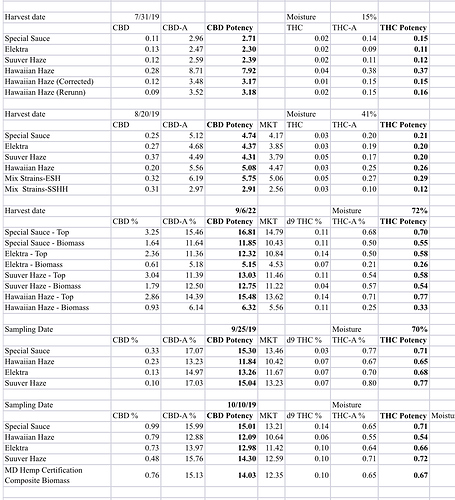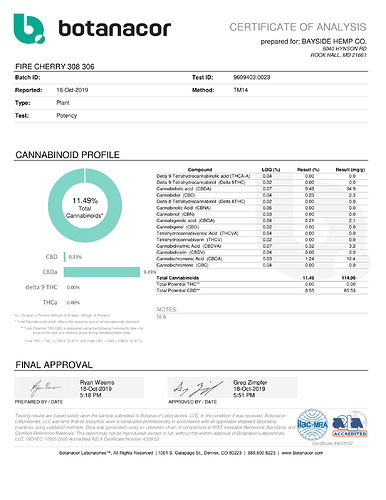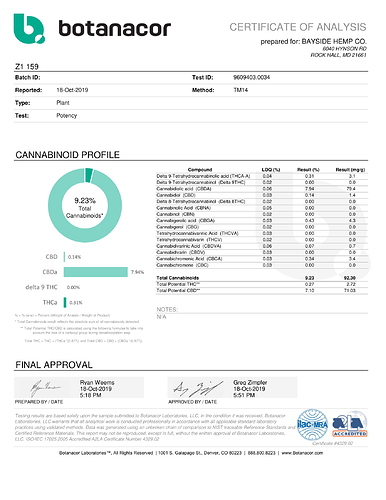It sure but I would assume it’s <.1 might be right at .9, or could be .5 % I could ask PSI though.
Ok I typed that last reply wrong. I’m not certain but assuming the LOQ for delta 9 is <.1 % it could be anywhere from .09-.01%
That would seem to support what @Autumn_Ridge_Hemp is seing in his hydro plants. Interesting. Thanks for sharing.
[quote=“Plague, post:31, topic:65072”]
If you want more THC, stress a plant out. I have noticed in sample testing that biomass given to us with no heavy metals had much lower THC (if not just straight compliant in flower before taken to crude and filtered) then ones that contained heavy metals.
I passed this along and my buddy commented it makes sense because thc is a repellant the plant produces to defend itself.
Here is a chart one of our partner farms that grew in Maryland this season showing the last few weeks on cannabinoid production. Keep in mind the east coast had ideal, hot and sunny weather. @Future Oregon CBD genetics
The terpenes are actually natural defense system of the plant.
That’s why I said I believe (because it’s yet to be proven or disproven) that the trichs are formed in high volume under stressful situations as a way to ensure reproduction. The diploid structure is in the RNA of all plants and if it feels it’s existence is threatened, it does everything it can to make sure that the species can carry on (think of adrenaline and the “fight or flight” mode).
It just depends on the enzymatic synthase that’s the most prevalent that will determine what cannabinoid climbs.
What was the moisture content on the tested plant matter and did it make it to full maturity or was it harvested early?
Where can I find a verified source of CBG strains? Seeds or clones ?
Oregon CBD
That’s not even a spoon.
That’s a sippy cup.
That’s the name of the company
People are just scared of the word crispr right now because they don’t understand how it works. Tell me this, why is it so dangerous to have crispr sequences in a certain population? It’s not much different than artificial breeding, as genes and sequences will pass down to the next generation by mating. It’s not going to spread through a whole ecosystem, just a population. Even still, most organisms already have crispr sequences in them. Crispr is natural form of defense against viruses, not some dangerous man made chemical that spreads through an ecosystem and wreaks havoc.
Law of Unintended Consequences (though technically misapplied based on its original application). We lack the full scope of knowledge to accurately and confidently state all potential outcomes of genetic modification. The fear is that it will create self perpetuating invasive species, or worse, trigger further mutations during reproduction and environmental stress that may lead to negative consequences for humanity or the environment.
With that mentality we might as well give up and not try to learn every possible thing we can about GE, right? Just because something is dangerous doesn’t mean you shouldn’t do it. Some of the biggest scientific breakthroughs have been achieved through serious risks.
Remember the computer hackers in the 80s who got arrested and jailed for years without trial or even a phone call because people thought they could hack the worlds nukes and start ww3 by whistling into a phone?
Who makes the laws that allow or disallow scientific research? Politicians.
Never give politicians too much credit for knowing things before making decisions. There is no telling what the average congressman thinks a biohacker can do.
The end result? Limited research and a limited pool of knowledge.
The cause? Fear.
Human genetic modification is a whole different ball game. The potential social impacts are devastating. Unless the tech is quarantined until the point where it’s affordable on broad scale, the only potential outcome is an insurmountable increase in class gaps. How could the poor and middle class ever hope to get ahead if they’re competing against costly genetic improvements. At what point to normal people become obsolete? How long before job posting require “advanced cognitive genetic modification” or some other crazy stuff? Or even simpler, how long do we watch people die from genetic based diseases while those with the means edit it out of their population?
The fear that harmful mutations could arise from crispr edited organisms is just unfounded. Any organism could have a harmful mutation at any time. The threat is still there. Just because it’s crispr edited doesn’t make the chance of a harmful mutation greater. There’s no evidence for that.
That’s why it needs to be legal for everyone to use, not limited to huge corporations. That’s why I’m able to have a molecular bio lab in my extra room of my house, but the government is trying to limit public use of GE as much as they can
The fear isn’t about a harmful mutation. A rather mundane improvement, that in itself is not harmful, has the potential to unbalance an ecosystem. We’ve seen how poorly we’ve handled invasive species, what would suggest that this would be any different?
Edit: Case in point - Africanized bee - Wikipedia
Edit 2: I did cite further mutations as a possible consequence, but its secondary to environmental balance.



